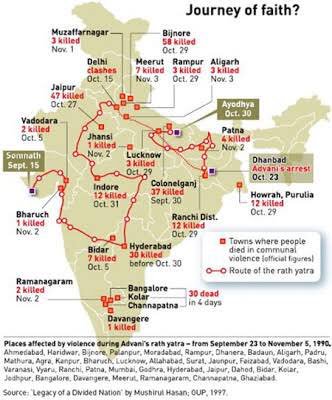As the judiciary represents the Indian state, showcasing the symbology of one particular religion in courts is surely wrong.

Ganpati temple within the premises of the Juvenile Justice Board and CWC, Mumbai. Credit: Arya Raje
India is a secular nation, and the fundamental rights make it a constitutional mandate for the state to not discriminate on the basis of religion. The court is an institution of the state, one where millions of people knock on its doors seeking justice. People accused of crimes are brought before it, victims of crimes and their families go there and a large number of people work in courts as lawyers, court officers, clerks and judges. The doors of the court are open to all those in India who seek justice or are caught in the judicial system, while also being a source of employment to many; the judicial space is one which is inhabited by diverse people.

People sitting on the fence because of a lack of seating space at the JJB and CWC, Mumbai.Credit: Arya Raje

Sessions court, Mumbai. Credit: Arya Raje
A secular state, thus, is one which does not endorse any particular religion to the exclusion of others. The state should observe an attitude of neutrality and impartiality towards all religions, as the state is concerned with the relations between humans, and not with the relation between humans and God, which is a relation of individual conscience and personal liberty. No religion can be upheld as the religion of the state.
Religion and jurisprudence in the US
Let us also take a brief look at jurisprudence in the US, which is similar to India in the sense that the state purports to be secular, and has one particular religion which is observed by the majority.
Courts in the US have in several cases considered the legality and constitutionality of placing religious symbols in courts and public places. Most cases in the US arose when counties placed nativity or Christmas-themed displays during the season or displayed the biblical ten commandments within the premises of a courtroom. By and large, these symbols and displays have been struck down because they appear to endorse a particular religion, in this case, Christianity.

Religious idols on the walls of the filing department at Dindoshi sessions court, Mumbai. Credit: Arya Raje
Secularism is perhaps perceived a little differently in India, where religion is, for many of its people, an inextricable part of life, woven into the fabric of our society. We grapple between ‘no concern secularism’ which advocates a strict ‘wall of separation’ between the functions of the state and religious practices, and ‘equal respect secularism’ which can be compared to the idea of ‘Sarva Dharma Sambhava’, mandating recognition and acceptance of religious practices.
However, while we have a multiplicity of religions and religious beliefs, the symbols in courts appear to be only those of Hindu gods, thus excluding those who follow other religions as well as those who do not subscribe to any faith. In fact – not only are these idols exclusively of Hindu deities, they are also images of those gods which are typically worshipped by the mainstream upper caste – a specific kind of Hinduism. If no particular religion is supposed to receive patronage from the state at risk of excluding others, what does it mean when only Hindu symbolism is prevalent in a court room?

Swastikas on the filing cabinets at Dindoshi sessions court, Mumbai. Credit: Arya Raje
US courts have noted that when the government displays something which is unquestionably religious, it introduces the threat of exclusion and divisiveness. Indeed, showcasing Hindu gods in the courts does indicate that the state is endorsing this particular religion. It appears to be state sponsorship of the Hindu religion. This could be alienating to those who profess another faith or to those who do not follow any religion. This kind of imagery in courts propagates and perpetuates the notion of the dominance of a Hindu majoritarian culture in the Indian state.
One possible way to demonstrate that the judiciary is secular and objective could be by adding symbols from other religions to indicate that the state is not favouring one religion over others. Or, instead of attempting to address the issue of fair representation of all faiths and sects in India within a space which is occupied by the state, they could simply remove all the symbols exclusively associated with Hinduism from courts’ premises, leaving them free of all religious imagery altogether.
Arya Raje is a lawyer practising in Mumbai. She has a Masters
degree from UCLA School of Law and works in the area of human rights law
and advocacy.


